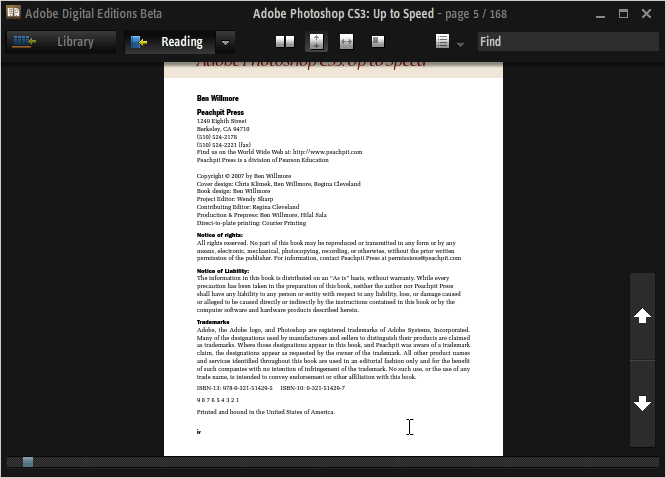3rd June 2007

For now, I still have my eye on Photoshop CS3, and it was with interest that I noticed that Peachpit Press had published a book, entitled Adobe Photoshop CS3: Up to Speed, exploring the changes made from CS2. The plot thickened when I found that I could download as an e-book.
However, it was then that I discovered a major change made to Adobe Reader for its eighth version: it no longer reads what Adobe titles Digital Editions. For that, you need either the previous version or to download the beta version of Adobe Digital Editions (yes, it does rather appear that they couldn't tie up the final release dates), which appears to be a Flash front end to Reader.
As it happens, I am not so convinced by this development: the thing is in essence coloured black and the mouse pointer disappears a lot of the time. Having menus and navigational screen furniture constantly disappearing and reappearing doesn't do much to enhance the reputations of Adobe's user interface designers. While it wouldn't be too bad if you could customise the colours, you can't; a light grey has to be better than black. Its taking over the whole screen when maximised is another irritation, especially when it covers up your task bar and the Alt+Tab shortcut is needed to leave it without having to hit the minimise button.
Yes, it does do the job, but I still find myself hankering after an Adobe Reader style interface and I have no idea why this has been foisted upon us when the previous approach was a perfectly good one. All in all, I have only to say it seems a premature roll-out of the approach. Now, where's Reader 7 when I need it?
16th March 2007
We have seen the beta come out, an unprecedented move for Adobe, and now we are hearing about the new professional editions of Photoshop: Photoshop CS3 for digital imaging and Photoshop CS3 Extended with tools for processing digital video. Together with Photoshop Lightroom for digital photography and Photoshop Elements for the consumer market, it appears that Photoshop is moving from a single application to becoming a big family of them. Adobe is hosting an online launch for the CS3 suite on March 27th so the appearance on the market of the new Photoshop must be very imminent. In the light of this, I think I’ll hold off on a decision to purchase either Elements 5 or its CS2 until I have tried out the latter’s successor.
Update: I’ve just perused both .Net’s and Advanced Photoshop’s initial appraisals of Photoshop CS3. Since they seemed impressed, it should be worth a look then. Another tempting idea is to have a taste of Lightroom, so I went and downloaded the 30-day trial version. I may well have a go with it in my own time; I’m not wanting to install it and let the 30 days run out before I get to use it in anger.
28th February 2007
Having exhausted the trial time on Photoshop Elements 5, I am now having a look at its big brother, Photoshop CS2. That has got me thinking about Photoshop books so that I become more of the possibilities and how to use them.
Having a Safari subscription as I do, that naturally became my first port of call, and I seemed to find two that answered my needs: both are by Scott Kelby; they now lie on my Safari bookshelf: The Photoshop Elements 5 Book for Digital Photographers and The Photoshop CS2 Book for Digital Photographers.
Even so, I am tempted to get a dead tree version of one of them and that presents a chicken-and-egg dilemma: the books could help choose which software to buy and the software dictates which of them will be the more useful. That said, I suspect price and features will swing it the way of Elements 5; paying over £400 for software whose capabilities I may never need does not sound financially sensible.
Update March 5th, 2007: Now, I have got my hands on the dead tree edition of Scott Kelby's The Photoshop Elements 5 Book for Digital Photographers as well as Brad Hinkel's Focal Easy Guide to Photoshop CS2. Now for some reading...
